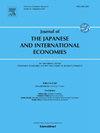Population aging, government policy and the postwar Japanese economy
IF 3.1
3区 经济学
Q1 ECONOMICS
Journal of the Japanese and International Economies
Pub Date : 2022-06-01
DOI:10.1016/j.jjie.2022.101191
引用次数: 8
Abstract
This paper analyzes the Postwar Japanese economy with a parsimonious neoclassical growth model that incorporates the demographic transition in Japan. We find that i) the increase in the aged population share can account for most of the decline in employment and reduced output by 8%, ii) workweek shortening policy led to a 20% reduction in output from its potential level by reducing hours worked over the 1988-1994 period, iii) the rise in labor tax led to an 11% reduction in output from its potential level by discouraging hours worked, iv) the shift in the composition of government spending may have caused a slowdown in productivity growth and hence a reduction in the potential output level itself.
人口老龄化,政府政策和战后日本经济
本文用一个简约的新古典增长模型分析了战后日本经济,该模型包含了日本的人口转型。我们发现,1)老年人口比例的增加可以解释就业下降的大部分原因,产出减少了8%;2)缩短工作周的政策通过减少1988-1994年期间的工作时间,导致产出从潜在水平下降了20%;3)劳动税的增加通过减少工作时间,导致产出从潜在水平下降了11%。政府支出构成的转变可能导致生产率增长放缓,从而降低潜在产出水平本身。
本文章由计算机程序翻译,如有差异,请以英文原文为准。
求助全文
约1分钟内获得全文
求助全文
来源期刊
CiteScore
5.10
自引率
6.90%
发文量
36
期刊介绍:
The Journal of the Japanese and International Economies publishes original reports of research devoted to academic analyses of the Japanese economy and its interdependence on other national economies. The Journal also features articles that present related theoretical, empirical, and comparative analyses with their policy implications. Book reviews are also published.

 求助内容:
求助内容: 应助结果提醒方式:
应助结果提醒方式:


